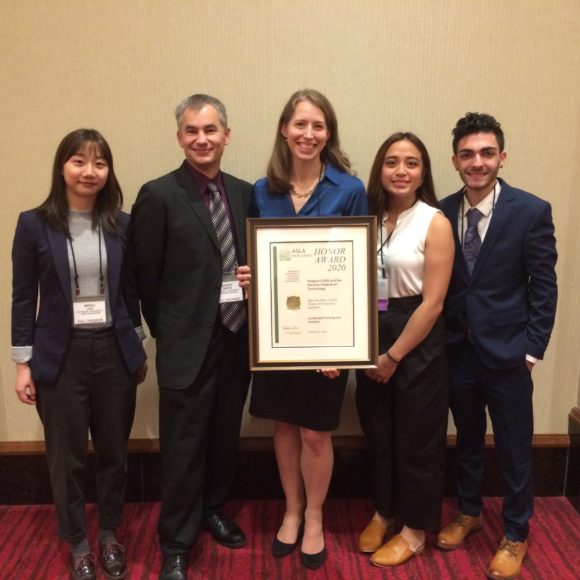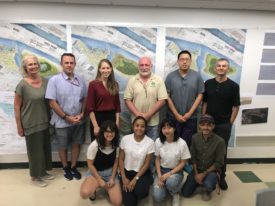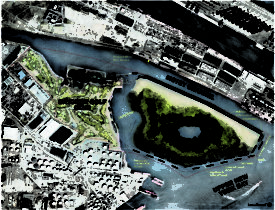
CUES team with the award (left to right: Mouli Luo, Brady Smith, Angela Johnsen, Zoe Orlino, Giovanni Caputo.) Project PIs Richard Alomar & Frank Gallagher, Beth Ravit and Bioenvironmental Engineering student Federico Liu Yang were unable to attend.
The Center for Urban Environmental Sustainability (CUES) led by Richard Alomar, associate director of the Office of Urban Extension and Engagement and associate professor in the Department of Landscape Architecture, and Frank Gallagher, Environmental Planning Program Director and Associate Professor of Professional Practice in the Department of Landscape Architecture, received a 2020 Professional Honor Award from the New Jersey Chapter of the American Society of Landscape Architects during the Chapter’s annual meeting in Atlantic City in February.
The award recognizes outstanding Landscape Planning & Analysis for the Bayonne Urban Coastal Design: An Integrated Approach project, a collaboration with engineers from the Steven Institute of Technology. The project provides three island design options for wetlands owned by the Bayonne Golf Club in the Upper New York Bay in order to increase storm surge resiliency in eastern Bayonne, New Jersey, and to create desperately needed habitats identified in the Hudson-Raritan Estuary Comprehensive Restoration Plan (CRP).

CUES Bayonne project team (back left to right: Beth Ravit, Richard Alomar, Angela Johnsen, Frank Gallagher, Federico Liu Yang, Brady Smith. Front left to right: Aleeza Langert, Zoe Orlino, Mouli Luo, Giovanni Caputo).
As project co-principal investigators, Alomar and Gallagher along with Beth Ravit, then co-director of CUES, led the multi-disciplinary team of landscape architects, environmental planners, environmental scientists, and civil, environmental and oceanic engineers, as well as local and state agency representatives. “The project confirms the value of multidisciplinary collaboration and demonstrates the importance of research based design in addressing today’s complex environmental issues,” said Alomar.
Designs were based on detailed analysis of existing conditions, regulatory determinations, scientific literature, similar ecological restoration case studies, construction best practices, and future sea level rise and storm surge projections.
Each distinct island design converts approximately 175 acres of mud sediments to shoreline and shallows, transition grassland, and maritime forests, stressing three major system components: Coastal Protection, Designed Ecological Systems, and Adaptive Management to support long-term performance.
The Links Island design echoes the golf course’s form and topography, incorporating high and low saltmarsh systems and a freshwater collection area. The Bird Island option increases habitat and biodiversity for as many species as possible, including existing mudflats as additional foraging areas for birds and crabs.
Finally, the Estuary Terminal Island proposal draws inspiration from the adjacent historic Military Ocean Terminal, integrating form with protection, and includes alternative energy options. According to Gallagher, “All of the options demonstrate how improving coastal shoreline ecology is key to developing healthy and resilient cities.”
The project report is available at The Center for Urban Environmental Sustainability website.
(Note: all photos courtesy of CUES.)


